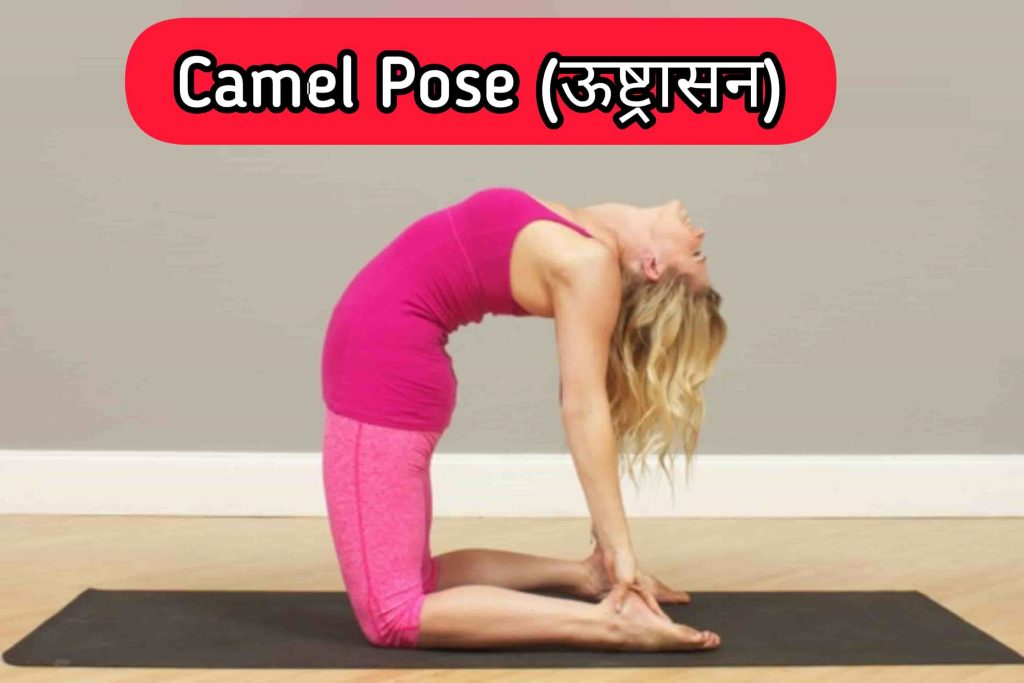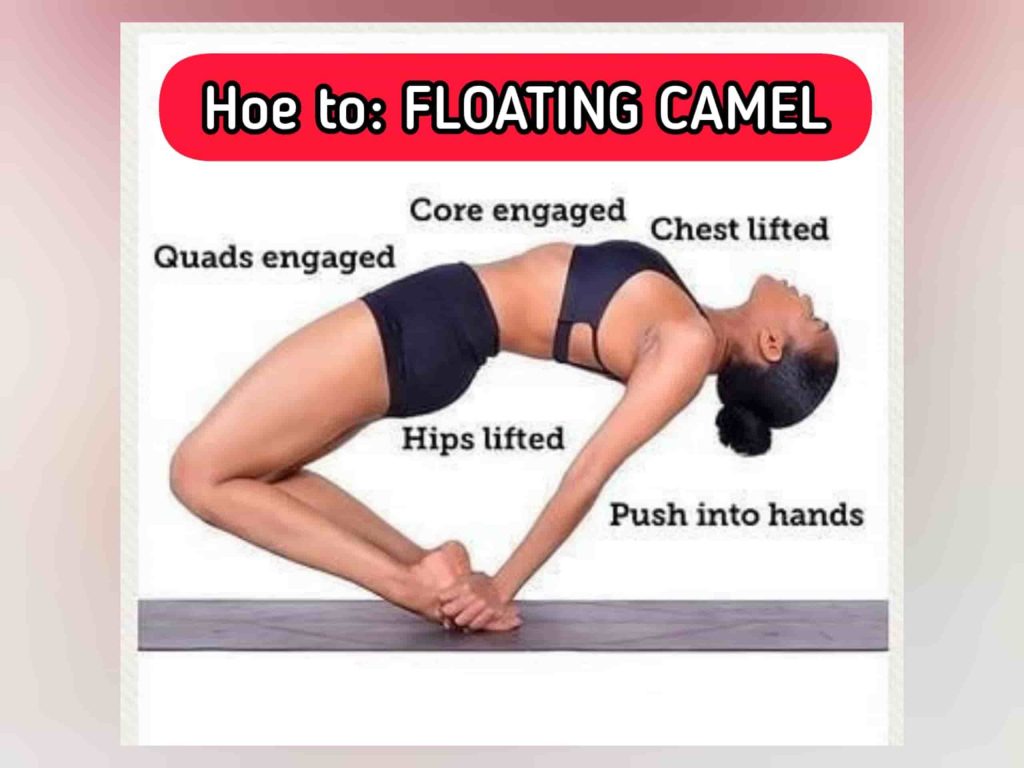Floating Camel Pose is an advanced version of Camel Pose. This allows you to experience deep spinal extension without having to support your weight with your arms. It is an even more flexible currency.
With Props, you have a lot of options for positioning your hand. In a sequence, it is often followed by a table, hero, or child pose. After the performance of the floating camel pose, you can go to the gate, half circle or child.
This posture is a wonderful back. It should be practiced in the morning along with other yoga asanas. But if you cannot manage time for your morning workout, then an evening yoga routine will also work wonders for you.
This asana should be practiced when your stomach and intestines are empty. Make sure you have your meal at least four to six hours before your practice.
What are the benefits Floating Camel Pose?
There are terms of benefits of floating camel pose include:
- Stretches and opens the front of the body, particularly the chest, abdomen, quadriceps, and hip flexors. It also strengthens the back and shoulders.
- Floating camel pose creates space in the chest and lungs, increasing breathing capacity and helping to relieve respiratory ailments.
- Relieves the body of lower back ache.
- Improves flexibility of the spine and also improves posture.
- This pose also stimulates the kidneys, which improves digestion.
- This pose energizes the body and helps to reduce anxiety and fatigue.
- Helps overcome menstrual discomfort.
- Stimulates energetic centers in the body, primarily the chakras located in the navel, heart, and throat.
What are the Precautions?
While Floating Camel Pose can have numerous benefits for the body and mind, it is a challenging and advanced yoga pose that may not be suitable for everyone. Here are some precautions and contraindications to consider before practicing Floating Camel Pose:
- Neck injuries: If you have any neck injuries, such as a herniated disc or a pinched nerve, it’s best to avoid Floating Camel Pose or practice it with caution. The pose involves a deep backbend that can put pressure on the neck and exacerbate any existing injuries.
- Lower back pain: If you have lower back pain or stiffness, it’s important to practice Floating Camel Pose with caution and avoid overextending the lower back. It’s recommended to warm up the body with other backbends and stretches before attempting this pose.
- Shoulder injuries: If you have any shoulder injuries, such as a rotator cuff tear or frozen shoulder, it’s best to avoid Floating Camel Pose or modify it by using blocks or props to support the arms and shoulders.
- High or low blood pressure: Floating Camel Pose can cause changes in blood pressure due to the intense backbend and inversion. If you have high blood pressure or low blood pressure, it’s essential to practice this pose with caution and consult with a doctor or qualified yoga instructor before attempting it.
- Pregnancy: Pregnant women should avoid practicing Floating Camel Pose, especially during the second and third trimesters. The pose can put pressure on the abdomen and may not be suitable for the changing needs of the body during pregnancy.
Overall, it’s important to approach Floating Camel Pose with caution and listen to your body’s needs and limitations. If you have any concerns or medical conditions, it’s best to consult with a doctor or qualified yoga instructor before attempting this pose. Modifying the pose with props or practicing a gentler variation may be more suitable for your needs and abilities.
It is best to practice this asana under the supervision of a yoga instructor.
How to prepare for floating camel pose?
If you have not done Ustrasana, then floating camel pose is not for you yet.
1. Prepare for camel pose
Practice on camel pose to achieve floating camel gaol, and before go for Camel poae, You first work on these asanas:
- Virasana (Hero Pose)
- Supta Virasana (Reclined Hero Pose)
- Bhujangasana (Cobra Pose)
- Parighasana (Gate Pose)
- Dhanurasana (Floor bow)
- Salabhasana (Locust pose)
2. How to camel pose?

- Start kneeling at the top of your mat with knees below your inner hip points. Keep your legs parallel to each other.
- Place your hands on your lower back / sacrum so that your fingers point downwards.
- Guide your tailbone down. Hold your thighs back as you start breathing to elevate your heart.
- Find the extension through your heart by bringing the shoulder blades into your back ribs.
- Start leaning back without dropping your head. Keep your chin close to your sternum.
- With your hands still on your sacrum, get constant depth to pull your shoulders together, focusing on the length and extension of the pose rather than the depth.
- Once you can move forward, the option to reach back with one hand at a time to find your feet.
- If your toe is tucked, your hands will rest on your heel. Otherwise, they will rest on the soles of your feet.
- Pull your front ribs to keep your stomach soft and your spine long. Use your hands against your feet through your heart and sternum with each breath.
- At this point, you can choose to rear your head or place your head in a more neutral position with the neck.
- Hold for 60 seconds. To release the pose, return your hands to your pelvis and use the breath to come up, pushing the points of the hip down for support.
- Lead with your heart, head coming past. Sit your hips on some heels to feel the remains of the pose.
3. How to do floating camel pose?

- Begin with hero pose, by kneeling on your mat, keep your weight balanced equally across both sit bones.
- Keep in mind that the tops of your feet are pressing equally into the floor.
- Wrap your hands around balls of feet, when ready hands on the balls of feet, then inhale.
- Gently tilt your body backwards and lift the hips for knees off the floor.
- Working slowly, from the knees, slowly push head back raise the shins off the floor and come into Floating Camel Pose.
- You must ensure that you have engaged your hips, core and you have lifted chest, hips.
- Stay in position for about 30 to 60 seconds, before you coming back from this pose.
Keynote: Make Sure You Use support for the feet and practice against the wall if doing this for the first time.
4. Follow-up Poses:
- Dandasana (Staff pose)
- Balasana (Child’s pose)
- Urdhva dhanurasana (Upward facing bow)
- Dhanurasana
- Sarvangasana
- Setu Bandha














